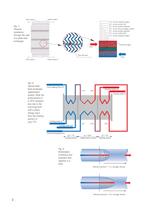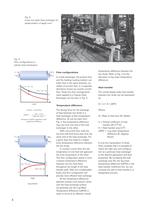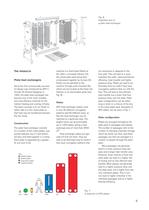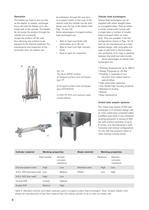
Catalog excerpts

Flow direction Inlet media 1Outlet media 1 Inlet media 2Outlet media 2FlowTurbulent regionFlow T Across turbulent regionT Across surface filmT Across heat exchanger surfaceT Across turbulent regionT Across surface filmT Across product depositsT Across product deposits Heating media out Heating media in Regeneration section Cooling media inCooling media out Cold outgoing flow 4C 4ںC67C74ںC 74C Cold incoming flow 4ںC T = 63CT = 7ںC Cooling sectionT = 7C 11ںC Heating section > Velocity maximum = 1.2 x average velocity Velocity maximum = 2.0 x average velocity >
Open the catalog to page 2
Regeneration In order to optimise the efficiency of a process in which two flows are simultaneously heated and cooled, heat exchange systems can be de signed to recover the heat from the heated fluid and use the thermal energy to preheat the incoming cold flow. A typical flow arrange ment is shown in Fig. 2. > Turbulent vs laminar flow Elements of heat transfer Flow through heat exchangers is generally considered to take place in one of the following two flow regimes or in a state of transition between the two. Laminar flow, where the fluid may be visualised as flowing in ordered layers....
Open the catalog to page 3
Fig. 5: A pre-war plate heat exchanger for pasteurisation of apple wort. Heat transfer The overall steady state heat trans fer between two fluids can be expressed as:Q = U A Օ LMTDWhere: Q = Rate of heat flow (W, Watts) U = Overall coefficient of heattransfer (W / m2 / K).A = Heat transfer area (m2)LMTD = Log mean temperaturedifference (K, degreesKelvin)It is by the manipulation of these three variables that it is possible to match the right size and configura- tion of a particular heat exchanger to the desired application and fluid properties. By increasing the heat exchange area (A), the...
Open the catalog to page 4
Fig. 6:Exploded view of a plate heat exchanger. Plate configuration Plates are arranged throughout the plate pack in passages and passes. The number of passages refer to the number of individual channels through which the fluids can flow, and these passages can then be arranged in a number of passes through the plate pack. More passages will generally lead to a lower pressure drop per pass and a larger heat transfer area. However, lower velocity of fluid over each plate can lead to a higher risk of fouling and so less efficient heat transfer. More passes will generally lead to a higher...
Open the catalog to page 5
Hybrid The Fully Welded Heat Exchanger the HybridԔ combines the efficiency of the ParaFlow and a strong vessel construction. The Hybrid is available in all weldable and pressable materi- als. Compared to the traditional Shell & Tube Heat Exchanger the Hybrid is very compact and flexible in form and size. The Hybrid is suitable for appli-cations like Con den sing, Evaporation, Liquid/Liquid, Gas/Gas and Liquid/ Gas. ParaWelded plate technology If a plate heat exchanger is to be used for duties involving an aggres- sive medium which would otherwise attack plate gaskets over time, or for...
Open the catalog to page 6
ParaShell heat exchangers The ParaShell heat exchanger is con structed with the plates in a stack surrounded by an outer shell which encloses the plate pack. The product plates are welded together in pairs with the service medium then circulated through the outer case and between the plate pairs. The end cap can be fully-welded or manufactured so that it can be opened for inspection. The service medium is routed through indi vi dual passes via a baffle plate similar to the shell in the tubular type of heat exchanger. Compared with the normal plate- and-frame heat exchanger, the ParaShell...
Open the catalog to page 7
Tubular heat exchangers Tubular heat exchangers can be supplied with either straight tubes or corrugated tubes. They all follow a similar construction format with a single tube or number of smaller tubes enclosed within an outer shell. They are available in the four configurations shown in Figs. 16-19 and can be manufac tured as a fully-welded design, with removable end caps or with built-in thermal expan-sion protec tion of O-rings or pack ing between the shell and tube bundle.Some advantages of tubular heat exchangers are: Working Temperatures up to: 285պC Design Pressures to: 60 BarՕ...
Open the catalog to page 8
Rising / falling and falling film evaporators In these evaporators, the evaporator plates are either arranged in pairs of one steam plate and one product plate (the falling film evaporator), or in sets of four plates (the rising / falling film evap orator). With the rising / falling film unit, the feed is partially evaporated ris ing up the first set of plates, with the product / vapour mix being duct ed for final evaporation in the second set of plates. In the falling film evaporator, the feed is first introduced into a chamber above the product plate where flashing occurs, then this...
Open the catalog to page 9
Paraflash The Paraflash type of plate evapo rator operates under suppressed boiling with the product circulated around the evaporator. Vaporisa tion does not occur within the heat exchanger plate, instead the prod uct flashes as it enters the vapour / liquid separator. Suppressed boiling combined with high liquid velocities helps to reduce scaling on the heat exchange surface (see Figs. 24 and 29).The Paraflash evaporator is speci ally suited to products with a tendency to crystalise, with a starch content or with suspended solids. > SteamSteam sectionProduct sec-SectionFeedProductfrom...
Open the catalog to page 11
Tubular heat exchangers Services in general Mechanical repairs Օ Seal replacement Acid / alkaline cleaning Օ Pressure testing Material diagnosisՕ Maintenance contracts System expansion Օ Shutdown maintenance Scraped surface heat exchangers Grinding of barrelsՕ Blade replacement Motor, gearbox maintenance Օ Seal replacement > THER HEAT EXCHANGE PRODUCTS APV also covers a wide range of heat exchange products for more specialised processes. These include: Ohmic heating Օ Radio frequency heating Microwave heatingՕ Direct steam heating by infusion or injection. > USTOMER SERVICE FACILITIES...
Open the catalog to page 12
Fig. 27: Paravap utilised for the con cen-tration of corn syrup. > HE QUALITY APVs commitment to manufac turing quality products and pro vid ing high standards of service has earned us major quality certifications for the supply and manufacture of our heat exchange equipment throughout the world. Asme VIII (U) StampՕ ISO 9001 ISO 9002 Օ Lloyds quality assurance National accreditation of certification bodies. In addition heat exchangers can be designed to comply with any rele vant international pressure code such as:Օ AD Merkblatter StoomvezenՕ BS 5500 Asme VIII. > ONCLUSION In 1923, Dr...
Open the catalog to page 13All APV catalogs and technical brochures
-
CU4plus Series Control Units
1 Pages
-
SW4
2 Pages
-
DP4 – Piggable Valve
2 Pages
-
DW Series
8 Pages
-
Valve Key
32 Pages
-
DT4
4 Pages
-
77T
4 Pages
-
57T
4 Pages
-
APV Flex-Mix™ Liquiverter
2 Pages
-
VO-ll & VO-76
8 Pages
-
APV FX Milk Pasteuriser Unit
4 Pages
-
Multipurpose UHT Pilot Plant
8 Pages
-
D4 Series
8 Pages
-
APV FX Tubular UHT Plant
4 Pages
-
Thermal Processing Technology
20 Pages
-
Power+ Energy
44 Pages
-
LIQU E FI E D NATURAL GAS
32 Pages
-
Oil & Gas
21 Pages
-
APV Products & Services
8 Pages
-
The APV Flex-MixTM Family
8 Pages
-
DELTA AP1 Aseptic Valve
4 Pages
-
DELTA MS4/MSP4
8 Pages
-
Heat Transfer Technology
8 Pages
-
APV FX SepStream
4 Pages
-
Rannie/Gaulin type 125T
4 Pages
-
Rannie/Gaulin type 110T
4 Pages
-
APV Homogenizers
16 Pages
-
NR5 EasyFlow Heat Exchanger
4 Pages
-
APV ParaFlow
8 Pages
-
APV XL PLate Heat Exchangers
8 Pages
Archived catalogs
-
Nutritional Beverages
8 Pages
-
SPX FLOW
52 Pages
-
APV from A to Z
122 Pages
-
ParaFlow Power
4 Pages
-
Flow Technology Segment Overview
44 Pages
-
Flex-Mix Liquiverter
4 Pages
-
DELTA AP1 - Aseptic valves
4 Pages
-
W+ Centrifugal Pump
8 Pages
-
The APV LeanCreme Process
8 Pages
-
APV PUMA+ Centrifugal Pump
4 Pages
-
APV DW Rotary Lobe Pump
4 Pages
-
Lab Series Homogenisers
4 Pages
-
Water Desalination Unit
2 Pages
-
APV ParaBrazed
4 Pages
-
APV CurdMaster
4 Pages




























































